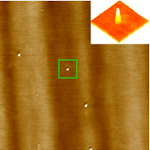The development of nanophotonic devices based on the generation, manipulation and detection of single photons is a crucial step for the realization of future quantum computers. Quantum computing logic will be no more based on classical bits, but on quantum bits (QuBits). Among various methods proposed for the realization of qubits, there is the epitaxial growth of semiconductor Quantum Dots (QDs), where charge carriers are quantum confined in all three dimensions, thus creating a nanosized "artificial atom". Among important properties of these structures, most relevant for the emission and manipulation of single photons are the strong excitonic effects and the easy integration in semiconductor devices. InAs QDs grown on GaAs, moreover, are highly compatible with current electronic and photonic technologies, thanks to the possibility of tuning the wavelength of QD photons in the optical window of the IR telecommunications. There are many future application areas for such quantum systems, but some commercial devices based on QDs for quantum cryptography are already in production. [1-2]
At the IMEM-CNR Institute of Parma, QDs are prepared by Molecular Beam Epitaxy (MBE). To act as single photon sources, these nanostructures must meet stringent requirements such as a very low surface density (few QDs for micron squared), high material quality and great control on the doping levels: such requests make MBE the best suited technique for the realization of these nanostructures. It was shown that the emission of individual QDs grown at IMEM-CNR can be tuned in the optical windows at 1.3 micron and, potentially, 1.55 micron. [3-4]
Furthermore, in collaboration with the group at the University of Valencia led by Prof. Juan P. Martinez-Pastor it was demonstrated that, using the Hanbury - Brown and Twiss (HBT) interferometric technique and illuminating the QDs with laser beams of different wavelength and low power, it is possible to detect single photons emitted by a single quantum dot simultaneously at two different energies (two colors). This has allowed us to propose a new architecture for one of the basic elements of computational logic (NAND gate ). [5]
This result was recently selected for the " Research Highlights" in Nature Photonics of April 2014 -
http://www.nature.com/nphoton/journal/v8/n4/full/nphoton.2014.66.html
[1] "Electrically driven single- photon source." ZL Yuan, BE Kardynal, RM Stevenson, AJ Shields, CJ Lobo, K Cooper, NS Beattie, DA Ritchie, and M Pepper. Science 2002 vol. 295 (5552) p. 102-105.
[2] "Coherent dynamics of telecom-wavelength entangled photon source" MB Ward , MC Dean, RM Stevenson, AJ Bennett, DJP Ellis, K Cooper, T Farrer, CA Nicoll, DA Ritchie, and AJ Shields. Nature Communications, 2014 vol. 5 pp.3316-3319.
[3] "Single quantum dot emission at telecom wavelengths from metamorphic InAs/InGaAs nanostructures grown on GaAs substrates" L Seravalli, G Trevisi, P Frigeri, D Rivas, G Munoz-Matutano, I Suarez, B Alen, J Canet-Ferrer, and JP Martinez- Pastor. Appl. Phys. Lett. 2011 vol . 98 (17) p .173112 .
[4] "Design and growth of metamorphic InAs / InGaAs quantum dots for single photon emission in the telecom window." L Seravalli, G Trevisi, P Frigeri. CrystEngComm, 2012 vol .14 (20) p. 6833-6838 .
[5] "Two-Color Single-Photon Emission from InAs Quantum Dots: Toward Logic Information Management Using Quantum Light " D Rivas, G Muñoz-Matutano, J Canet-Ferrer, R García-Calzada, G Trevisi, L Seravalli, P Frigeri, JP Martínez-Pastor. Nano Letters 2014 vol . 14 ( 2 ) , 456-463 .
Immagini:

